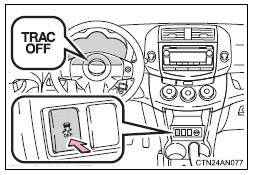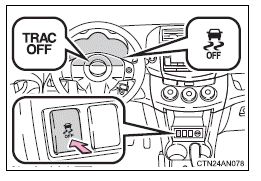 Toyota RAV4: To disable TRAC and/or VSC (4WD models)
Toyota RAV4: To disable TRAC and/or VSC (4WD models)
If the vehicle gets stuck in fresh snow or mud, TRAC and VSC may reduce power from the engine to the wheels. You may need to turn the system off to enable you to rock the vehicle in order to free it.
■ Turning off TRAC

Quickly push and release the switch to turn off TRAC. The “TRAC OFF” indicator light should come on. Push the switch again to turn the system back on.
■ Turning off TRAC and VSC

Push and hold the switch while the vehicle is stopped to turn off TRAC and VSC. The “TRAC OFF” and VSC OFF indicator lights should come on. Push the switch again to turn the system back on.
■Automatic reactivation of TRAC and VSC
Vehicles without smart key system
Turning the engine switch OFF after turning off the TRAC and VSC systems will automatically re-enable them.
Vehicles with smart key system
Turning the “ENGINE START STOP” switch OFF after turning off the TRAC and VSC systems will automatically re-enable them.
■Automatic TRAC reactivation
2WD models
If only the TRAC system is turned off, the TRAC system will be reactivated while vehicle speed is increased.
4WD models
If only the TRAC system is turned off, the TRAC system will turn on when vehicle speed increases.
■Automatic TRAC and VSC reactivation
If the TRAC and VSC systems are turned off, the systems will not turn on even when vehicle speed increases.
■When the “AUTO LSD” indicator light flashes even if the VSC OFF switch has not been pressed (2WD models)
TRAC, AUTO LSD, hill-start assist control and downhill assist control cannot be operated. Contact your Toyota dealer.
■When the “TRAC OFF” indicator light comes on even if the VSC OFF switch has not been pressed (4WD models)
TRAC, hill-start assist control and downhill assist control cannot be operated. Contact your Toyota dealer.
■Sounds and vibrations caused by the ABS, TRAC and VSC
●A sound may be heard from the engine compartment when the engine is
started or just after the vehicle begins to move. This sound does not indicate
that a malfunction has occurred in any of these systems.
●Any of the following conditions may occur when the above systems are
operating. None of these indicates that a malfunction has occurred.
• Vibrations may be felt through the vehicle body and steering.
• A motor sound may be heard after the vehicle comes to a stop.
• The brake pedal may pulsate slightly when the ABS is activated.
• The brake pedal may move down slightly after the ABS is activated.
■When the AUTO LSD function operates continuously
The brake actuator may overheat. In that case, the system will stop the AUTO LSD function, a buzzer will sound and the slip indicator will stay on steady. Refrain from using the AUTO LSD function until the slip indicator goes off. (There is no problem with continuing driving normally.)
■EPS operation sound
When the steering wheel operates, a motor sound (whirring sound) may be heard. This does not indicate a malfunction.
■Reduced effectiveness of EPS system
The effectiveness of EPS system is reduced to prevent the system from overheating when there is frequent steering input over an extended period of time. The steering wheel may feel heavy as a result. Should this occur, refrain from excessive steering input or stop the vehicle and turn the engine off. The EPS system should return to normal within 10 minutes.
■If the slip indicator comes on
It may indicate a malfunction in the VSC, TRAC and AUTO LSD function. Contact your Toyota dealer.
CAUTION
■The ABS does not operate effectively when
●Tires with inadequate gripping ability are used (such as excessively worn
tires on a snow covered road).
●The vehicle hydroplanes while driving at high speed on wet or slick road.
■Stopping distance when the ABS is operating may exceed that of normal
conditions
The ABS is not designed to shorten the vehicle's stopping distance. Always
maintain a safe distance from the vehicle in front of you in the following
situations.
●When driving on dirt, gravel or snow-covered roads
●When driving with tire chains
●When driving over bumps in the road
●When driving over roads with potholes or roads with uneven surfaces
■TRAC may not operate effectively when
Directional control and power may not be achievable while driving on slippery
road surfaces, even if the TRAC system is operating.
Do not drive the vehicle in conditions where stability and power may be lost.
■When the VSC is activated
The slip indicator flashes and a warning buzzer sounds. Always drive carefully.
Reckless driving may cause an accident. Exercise particular care when
the indicator light flashes and a buzzer sounds.
■When TRAC and VSC are off
Be especially careful and drive at a speed appropriate to the road conditions.
As these are systems to ensure vehicle stability and driving force, do
not turn off TRAC and VSC unless necessary.
■Replacing tires
Make sure that all tires are of the same size, brand, tread pattern and total
load capacity. In addition, make sure that the tires are inflated to the
appropriate
tire pressure level.
The ABS and VSC systems will not function correctly if different tires are
fitted
on the vehicle.
Contact your Toyota dealer for further information when replacing tires or
wheels.
■Handling of tires and suspension
Using tires with any kind of problem or modifying the suspension will affect
the driving assist systems, and may cause the system to malfunction.
 To disable TRAC and/or VSC (2WD models)
To disable TRAC and/or VSC (2WD models)
If the vehicle gets stuck in fresh snow or mud, TRAC and VSC may
reduce power from the engine to the wheels. You may need to turn
the system off to enable you to rock the vehicle in order to free it ...
 Hill-start assist control
Hill-start assist control
Hill-start assist control helps to prevent the vehicle from rolling
backwards when starting on an incline or slippery slope.
To engage hill-start assist control,
further depress the brake
pedal ...
See also:
Steering wheel lock
[For vehicles equipped with the keyless operation system]. For information on
operations for vehicles equipped with the keyless operation system, refer to “Keyless
operation system: Steering whe ...
Compass zone adjustment
Compass calibration zones
1. The zone setting is factory preset to
Zone 8. Refer to the “Compass calibration
zones” map shown above to verify that the
compass zone setting is correct fo ...
Replacing fog lamp bulbs (if equipped)
1. Make sure the fog lamp switch is
in the off position.
2. From underneath the vehicle,
carefully disconnect the electrical
connector from the bulb.
3. Remove the bulb from the lamp
assembly by ...
